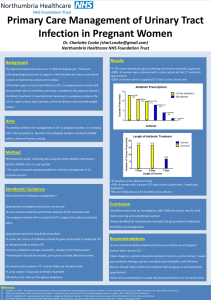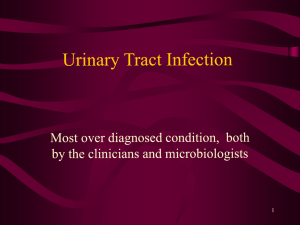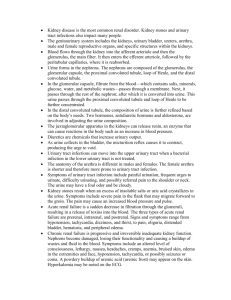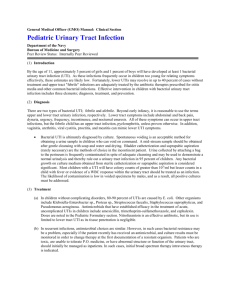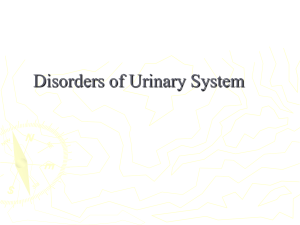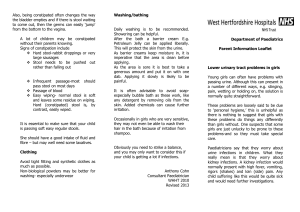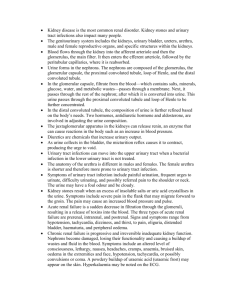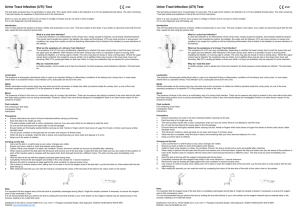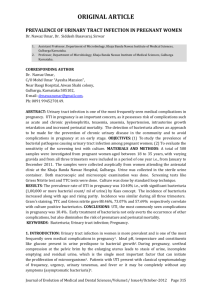URINARY TRACT INFECTIONS (UTI)
advertisement
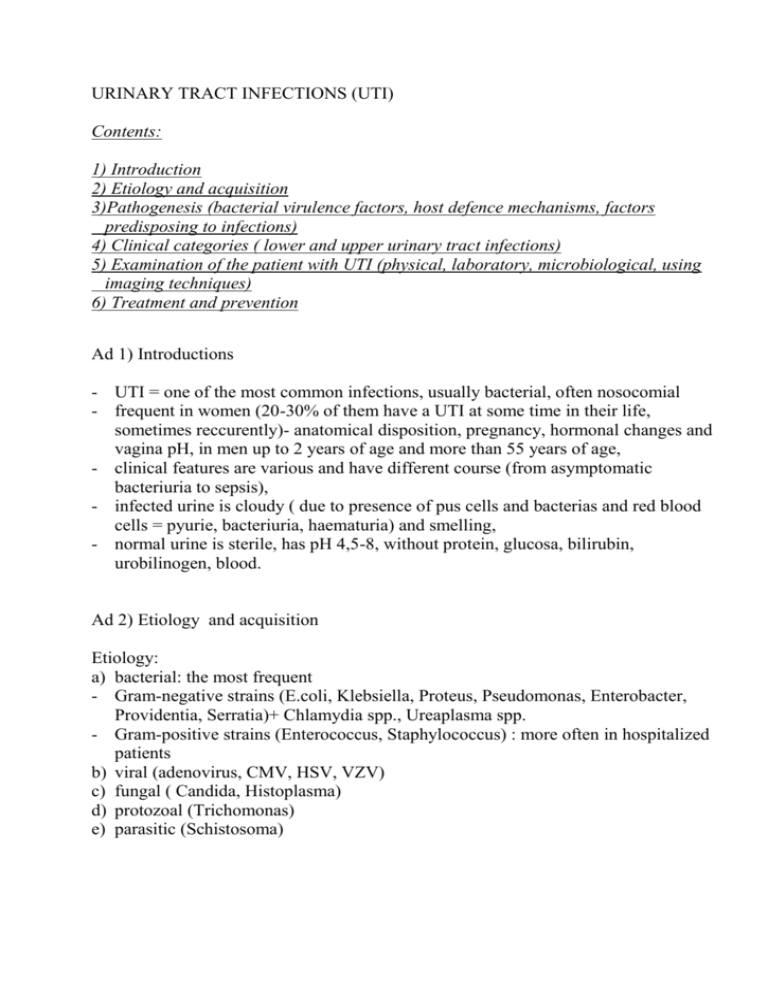
URINARY TRACT INFECTIONS (UTI) Contents: 1) Introduction 2) Etiology and acquisition 3)Pathogenesis (bacterial virulence factors, host defence mechanisms, factors predisposing to infections) 4) Clinical categories ( lower and upper urinary tract infections) 5) Examination of the patient with UTI (physical, laboratory, microbiological, using imaging techniques) 6) Treatment and prevention Ad 1) Introductions - UTI = one of the most common infections, usually bacterial, often nosocomial - frequent in women (20-30% of them have a UTI at some time in their life, sometimes reccurently)- anatomical disposition, pregnancy, hormonal changes and vagina pH, in men up to 2 years of age and more than 55 years of age, - clinical features are various and have different course (from asymptomatic bacteriuria to sepsis), - infected urine is cloudy ( due to presence of pus cells and bacterias and red blood cells = pyurie, bacteriuria, haematuria) and smelling, - normal urine is sterile, has pH 4,5-8, without protein, glucosa, bilirubin, urobilinogen, blood. Ad 2) Etiology and acquisition Etiology: a) bacterial: the most frequent - Gram-negative strains (E.coli, Klebsiella, Proteus, Pseudomonas, Enterobacter, Providentia, Serratia)+ Chlamydia spp., Ureaplasma spp. - Gram-positive strains (Enterococcus, Staphylococcus) : more often in hospitalized patients b) viral (adenovirus, CMV, HSV, VZV) c) fungal ( Candida, Histoplasma) d) protozoal (Trichomonas) e) parasitic (Schistosoma) Acqusition: a) by ascending route: bacterial infection is usually acquired by the ascending route from the urethra to the bladder and may proceed to kidney, ocasionally bacteria infecting the urinary tract invade the bloodstream to cause septicaemia. b) by hematogenous spread: less commonly infection may result from hematogenous spread of an organism to kidney, with the renal tissue being the first part of the tract to be infected. c) by lymphogenous route or per continuitatem: rarely (from cervix or rectosigmoideal area or due to perineal absces) Ad 3) Pathogenesis Normaly the balance exists between the host defence mechanisms and the bacterial virulence factors. a) Host defence mechanisms: With the exception of the uretral mucosa, the normal urinary tract is resistant to bacterial colonisation and usually eliminates microorganisms rapidly and efficiently thanks to: the washing-out mechanism of the urine, the pH of the urine and vagina, the chemical content of the urine, the presence of secretoric IgA antibodies in the mucosa. b) Bacterial virulence factors: The ability of some serogroups of E.coli to adhere to urethral and bladder epithelium is based on presence of fimbriae (pili). Some uropathogens, i.e.Proteus spp., have special enzymes (urease or haemolysins) ensuring some substances necessary for bacterial metabolism (iron...). The presence of the capsular antigen protects Enterobacteriacae from the phagocytosis and the bactericidal effect of the blood serum. c) Factors predisposing to infection: Mechanical factors are important. Anything that disrupts normal urine flow or complete emptying of the bladder, or facilitates access of organisms to the bladder, will predispose an individual to infection. (Obstruction due to lithiasis, tumours, prostatic hypertrophy, pregnancy, strictures of any sorts including congenital malformations , functional neuromuscular disorders e.g. spina bifida, paraplegia or multiple sclerosis, and also iatrogenic reasons -catheterization). Presence of some metabolic or immunologic disorder can also predispose infection ( i.e. diabetes mellitus decompensation). From this point of view we can clinically distinguish complicated and uncomplicated UTIs. Ad 4) Clinical categories of UTI a) - Upper urinary tract infections: acute and chronic pyelonephritis interstitial nephritis renal abscess, perinefritic abscess b) - Lower urinary tract infections: cystitis uretritis prostatitis Ad 5) Examination of the patient with UTI a) Clinical examination: - Anamnesis: Acute infections of the lower urinary tract are characterized by rapid onset of dysuria (= burning pain on passing urine), urgency (= the urgent need to pass urine) and frequency of micturition. The body temperature is usually normal or subfebrile. Acute infections of the upper urinary tract are characterized by lumbalgias (= unilateral or bilateral pain in the lumbar area), high body temperature, meteorism, sometimes nausea and vomiting. - Physical examination: Inspection of the external part of uretra and genitalia, abdominal palpation, tapottement, Israeli point In infants symptoms are often unspecific: subfebrile body temperature, gastrointestinal complaints, loss of apetite, non-prosperity, in children sometimes enuresis. b) Laboratory testing: Blood: Inflammatory signs - erythrocyte sedimentation rate (ESR), blood count, differential count, CRP, blood culture Biochemistry of the serum - urea, creatinin, natrium, potassium, chlorine ionts Urine: Biochemistry - pH, presence of protein, glucose, blood, bilirubuin, urobilinogen Microscopy of urine sediment - presence of leucocytes, erythrocytes, cylindres, epitelia, bacterias, mucus, crystals Microbiological investigation Microbiological investigation (urine cultivation): In health the urinary tract is sterile, although the distal region of the urethra is colonized with commensal organisms which may include periurethral and faecal organisms. Bacteriuria is defined as significant, when a properly collected midstream urine specimen is shown to contain more than 105 organisms per ml. Infected urine usually contains only a single bacterial species. Contaminated urine usually has less than 10 4 organisms per ml and often contains more than one bacterial species. Distinguishing infection from contamination when counts are between 104 and 105 organisms per ml can be difficult. The most often urine specimen for microbiological examination is a midstream urine sample (MSU), i.e. the urine obtaining after micturiting the first part of urine stream, which helps to wash out contaminants in the lower urethra. This should be collected into a sterile, wide-moithed container after careful cleansing of the labia or glans with soap (not antiseptic) and water. Collection of MSU samples from babies and young children is difficult and can be realized with a help of bag urine. This is plastic bag sticked to the perineum in girls or to the penis in boys. Next possibility how to obtain urinary sample is suprapubic aspiration of urine by a sterile needle directly from the bladder, or by cathetrisation of the urethra. c) Imaging techniques: Ultrasonography Radiography - native scan I.v. urography Radionuclear nephrography Computerized tomography Ad 6) Treatment a) High fluid intake oral or parenteral, complete bladder emptying (a postvoiding urine volume of more than 100 ml is associated with UTI). b) Symptomatic therapy (spasmoanalgetics), if necessary. c) Causative therapy (antibiotics oraly or parenteraly, if possible according to susceptibility of the etiologic agent).
